You are using an outdated browser. Please upgrade your browser to improve your experience.
This page requires JavaScript to work properly. Please enable JavaScript in your browser.
- Skip to primary navigation
- Skip to main content
- Skip to primary sidebar
- Skip to footer

The Opinionated Travelogue of a Photo Maniac
- Middle East
- North America
- South America
- Pacific Islands
- FOOD & WINE
- TRAVEL GUIDES
- TRAVEL RESOURCES
- Rants & Raves
- Travel Blogger Interviews
- Contact Form
- Privacy Policy
- Featured Elsewhere
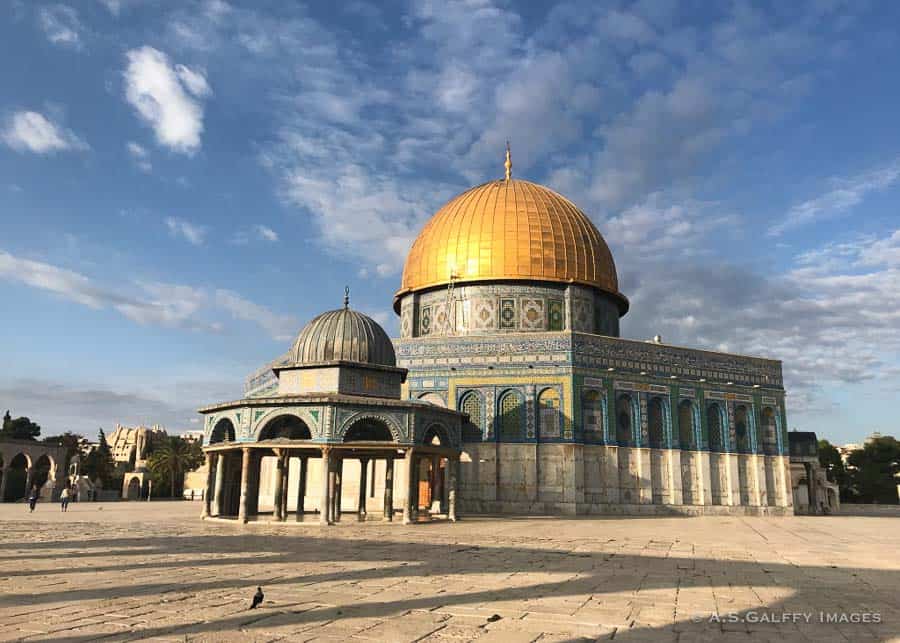

How to Visit Temple Mount & Dome of the Rock as a Tourist
Last Modified: January 20, 2024 // by Anda // 15 Comments
A visit to the Dome of the Rock and the Temple Mount was at the top of my list when I was planning our our trip to Israel . Temple Mount is one of the biggest attractions in Jerusalem , so I didn’t want to miss it. The site has been the most contested piece of territory in the Holy Land since Israel occupied East Jerusalem, in 1967.
Table of Contents
What is the Temple Mount and the Dome of the Rock?
The religious significance of the temple mount and the dome of the rock, who can visit the dome of the rock, how to access the dome of the rock, visiting hours and admission, what to expect when visiting the dome of the rock, dome of the chain, al-aqsa mosque, the purification fountain, fountain of qayt bay, how to dress when visiting temple mount and the dome of the rock, tips for visiting the dome of the rock and temple mount.
Temple Mount is a walled compound that sits above the Western Wall in the Old City of Jerusalem. The compound is the site of two magnificent structures: the Dome of the Rock to the north and the Al-Aqsa Mosque to the south.
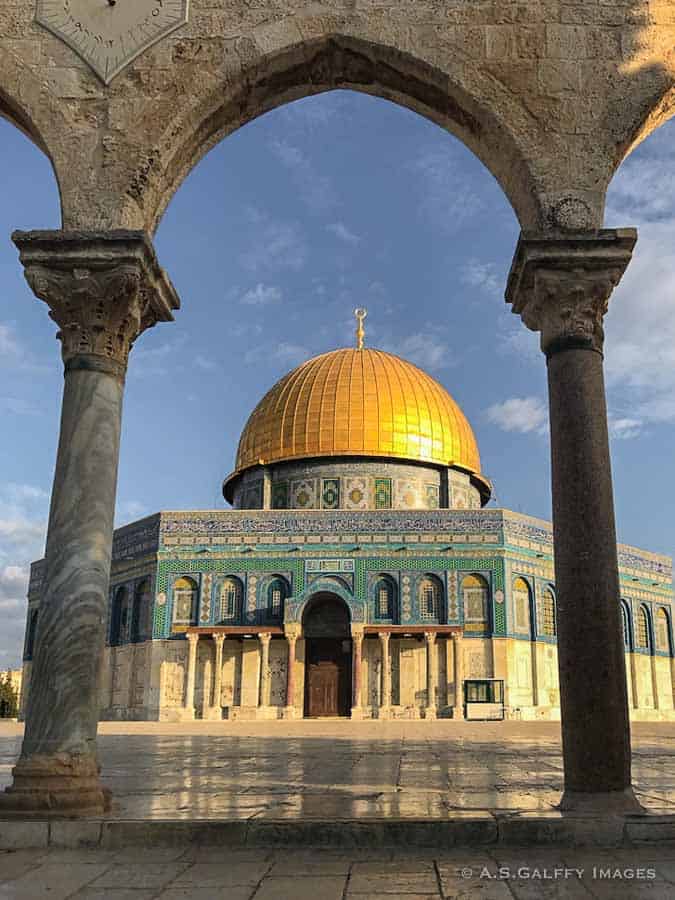
The Dome of the Rock occupies the area where the Holy Jewish Temple previously stood. The structure was completed in 692 AD, making it one of the oldest Islamic structures in the world. The Dome is a monumental building, beautifully decorated with mosaic, faience and marble. Much of these embellishments were added several centuries after its completion.
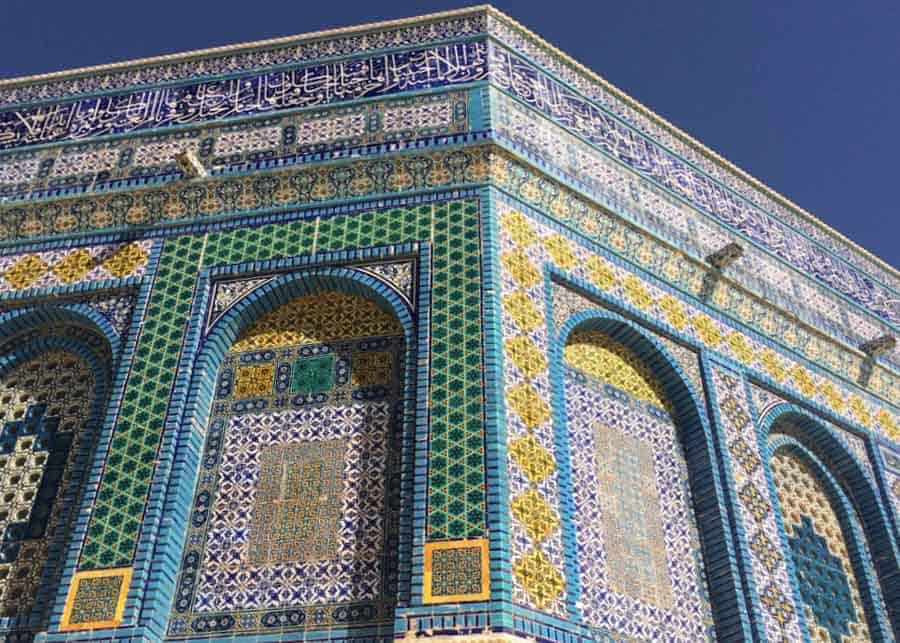
For Jews, Temple Mount is the holiest place on Earth because it’s the site where their two temples once stood. The First Temple was built by King Solomon and was destroyed by the Babylonians in 586 BC.
The Second Temple was built by Herod the Great in the 6th century BC and was destroyed by the Romans in 70 AD. Jews still continue to mourn the destruction of their temple to this day. They believe that that the temple is going to be rebuilt prior to the Messianic Age .
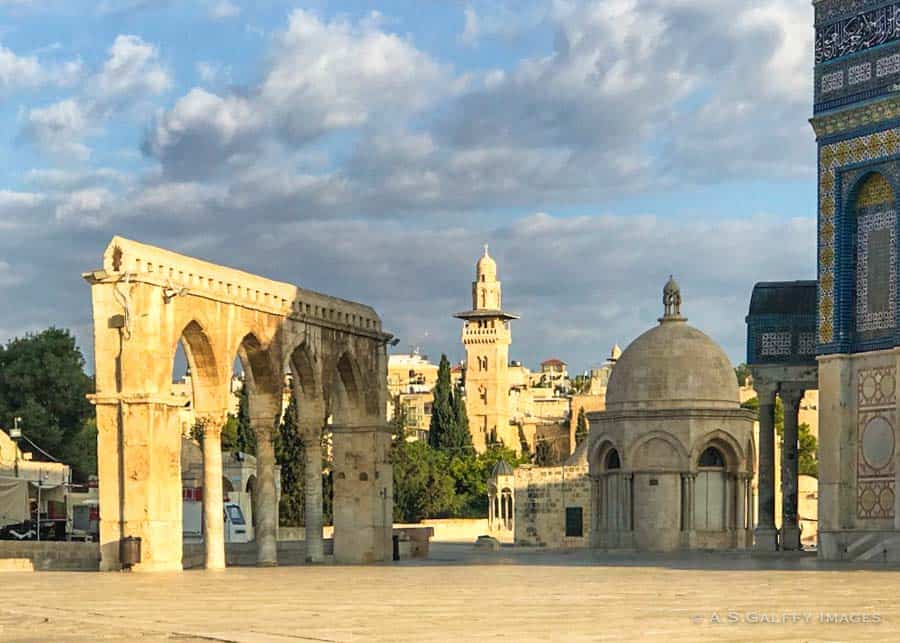
For Muslims, Temple Mount is known as Haram al-Sharif (the Noble Sanctuary) and is the third holiest site in Islam. They believe Prophet Muhammad ascended to heaven from this place in the 7th century. The Dome of the Rock was built over the Foundation Stone that marks the spot where Muhammad ascended into heaven.
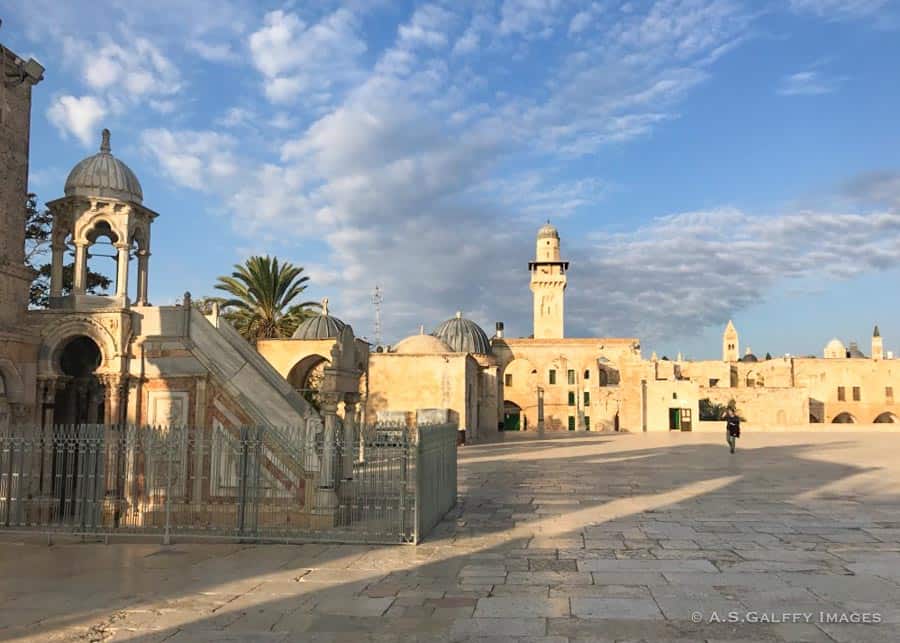
Since this place is holy to both Jews and Muslims, religious sensitivities have triggered violence, political chaos and tensions for decades. Despite the current truce, the peace is very volatile and the situation can get out of control at any moment.
Most tourists to Jerusalem want to visit the Dome of the Rock and Temple Mount. Sadly, while everybody can visit the Temple Mount complex, only Muslims can get inside the Dome of the Rock, or the Al Aqsa Mosque. As a non-Muslim, you can only visit the outside of these grandiose mosques and take pictures of them.
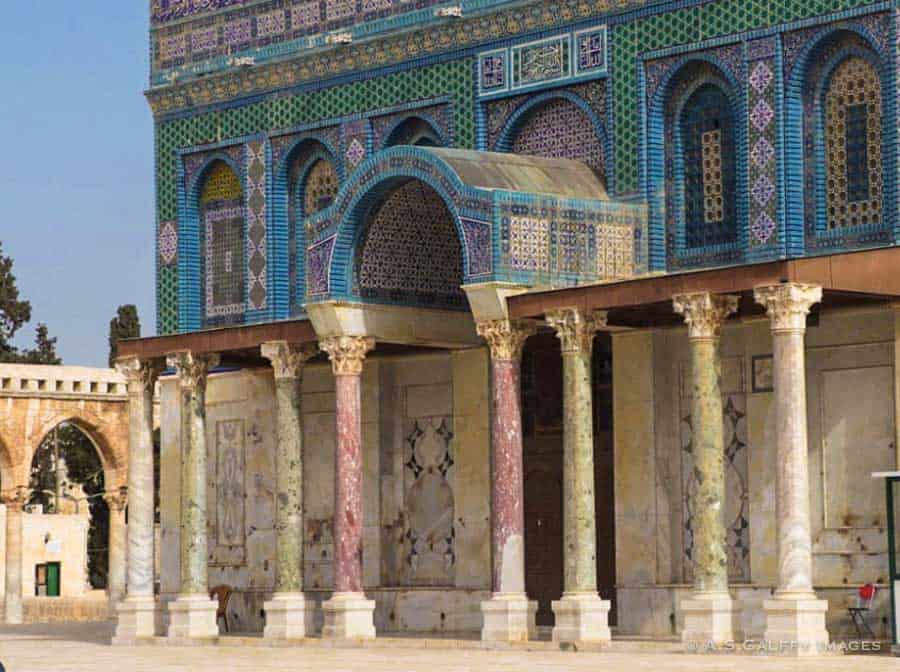
The Temple Mount is a prayer site for Muslims, who can pray here at any time. Christians and Jews may only visit the site as tourists, but are forbidden to pray on the Temple Mount.
The Dome of the Rock sits at the top of Temple Mount, which is currently under the control of the Jordanian government through the Waqf (the Islamic trust in Amman.) The Israeli government has control over the external security of the compound and can impose entry limits to the site.
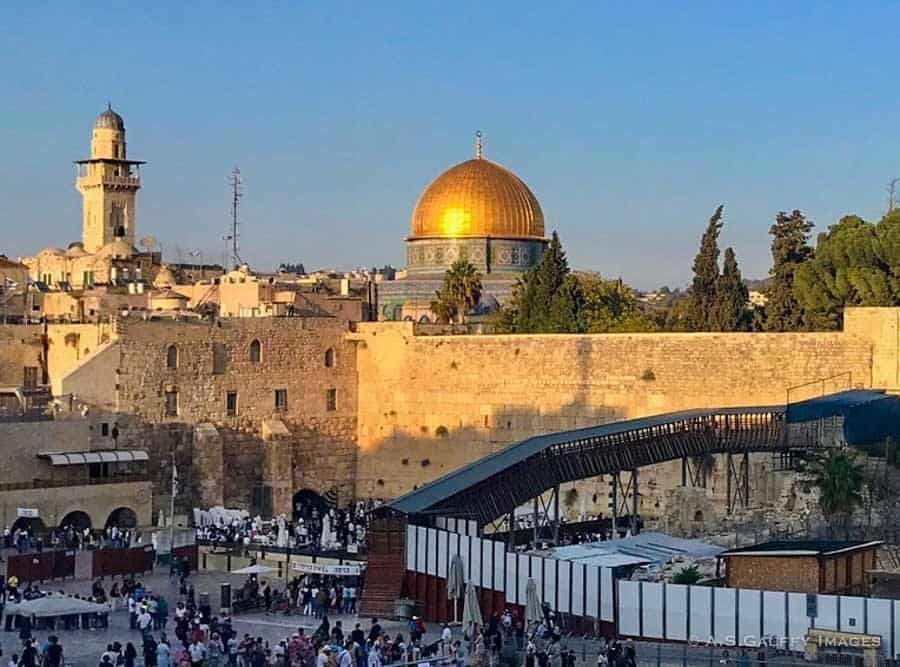
Muslims can access the Temple Mount complex through twelve gates, but tourists and non-Muslims can only enter through the Moroccan Gate which (also known as Mugrabi Gate ). This gate is located near the Western Wall Plaza, close to Dung Gate.
Admission for visiting Temple Mount and the Dome of the Rock is free. However, the site is only open during very specific times which causes very long lines.
Visiting hours for the Temple Mount are Monday through Thursday :
- Winter : 7:30 am – 10:30 am and 12:30pm – 1:30 pm
- Summer: 8:30am – 11:30am and 1:30pm – 2:30pm
The Temple Mount is closed to visitors on Friday and Saturday . It may also be closed without notice for security reasons.
We wanted to visit the Dome of the Rock without the crowds, so we came very early in the morning. To our surprise we were not the first ones in line, but at least the queue wasn’t very long.
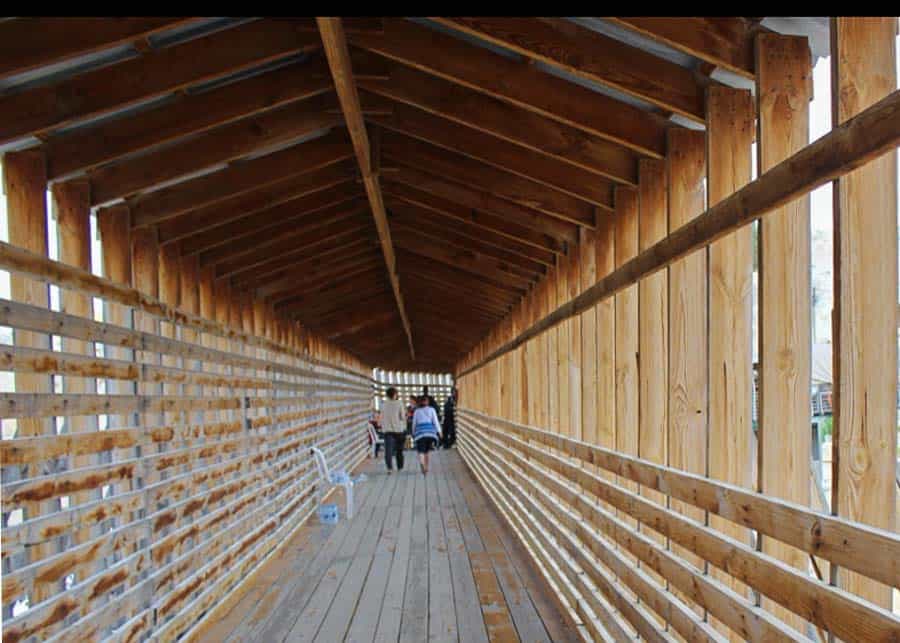
At the checking point we passed through metal detectors and had our backpacks and cameras x-rayed. They asked us if we had any prayer books or Bibles with us. We didn’t of course, so they let us pass. As we started walking up the wooden ramp towards the entrance gate, we noticed several men with semi-automatic rifles. This didn’t surpris, as military forces are omnipresent all over Israel.
Once we passed through the gate, we found ourselves in a large, open area where we could see the Al-Aqsa Mosque on the right and the Dome of the Rock on the left. It was around 7:45 a.m. when we arrived and the golden roof of Dome of the Rock was glittering the morning light.

As we began walking around taking pictures of the beautiful Dome, we noticed there many other structures around worth checking out.
Other structures to visit on Temple Mount, besides the Dome of the Rock
The biggest attraction on Temple Mount is of course the Dome of the Rock. But before rushing to the upper platform visit the Dome of the Rock, we took time to admire the beautiful arches ( qanatirs ) that frame the terrace. They have been built by the Mamluks, in the 15th century.
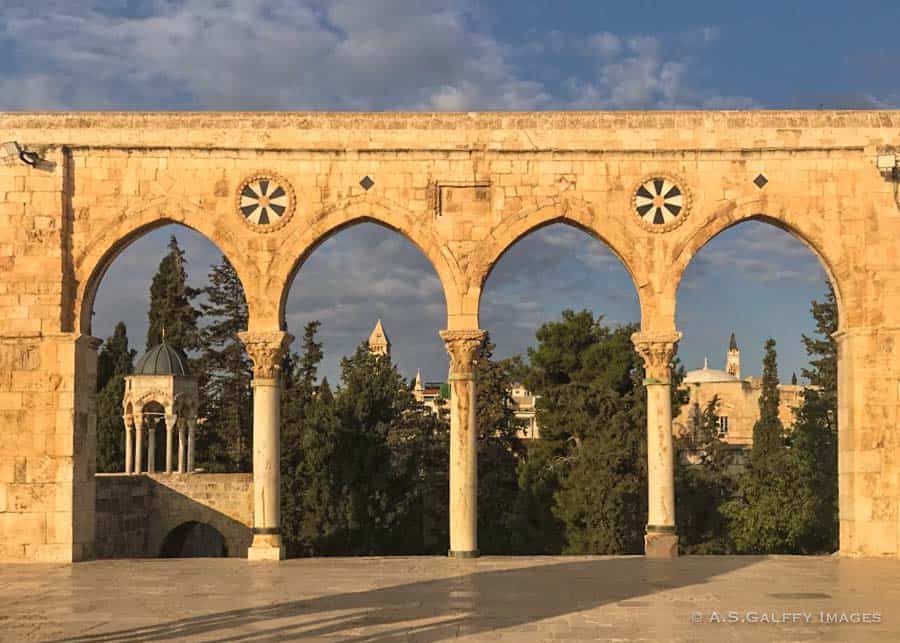
Located on the same platform and just adjacent to the Dome of the Rock, is a free-standing dome called the Dome of the Chain , which is one of the oldest structures on the Temple Mount. The dome is used as a prayer house.
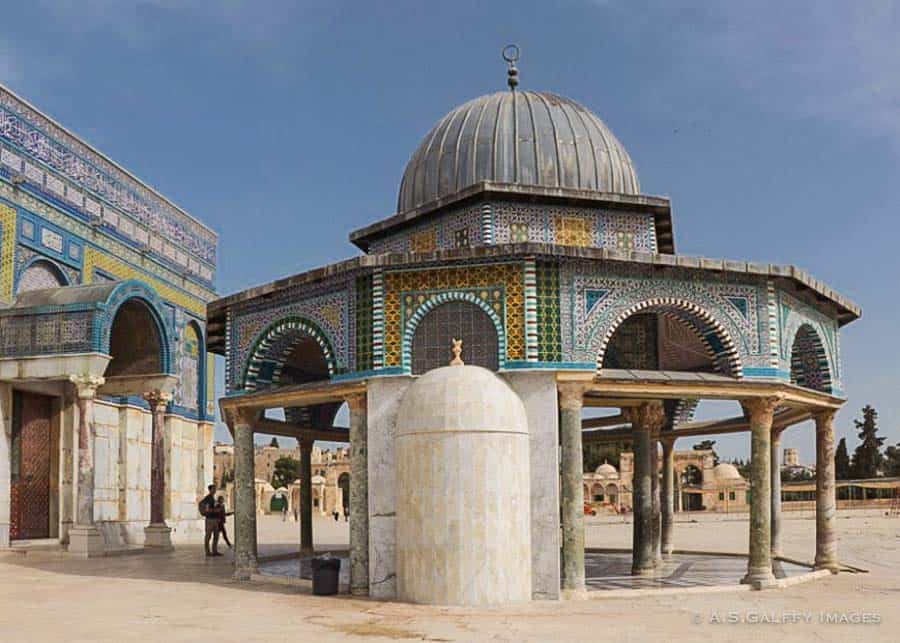
While the Dome of the Rock serves more as a shrine, Al Aqsa is a big functioning mosque that can accommodate up to 5000 worshippers at a time. It’s such a pity that we couldn’t get inside this beautiful mosque!
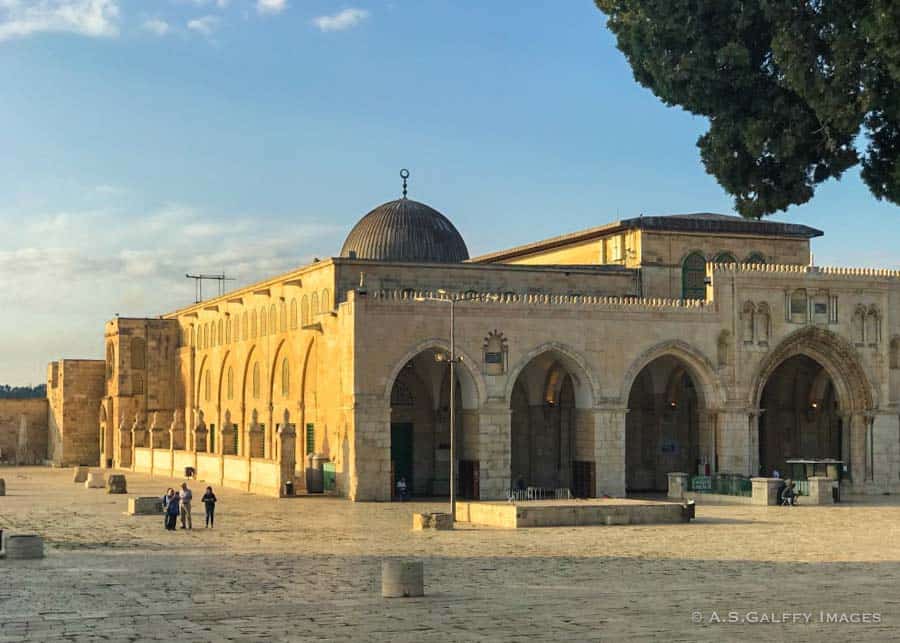
North to the Al Aqsa mosque there is a small fountain used for drinking and purification before prayers. The fountain is surrounded by a green metal fence and marble chairs.
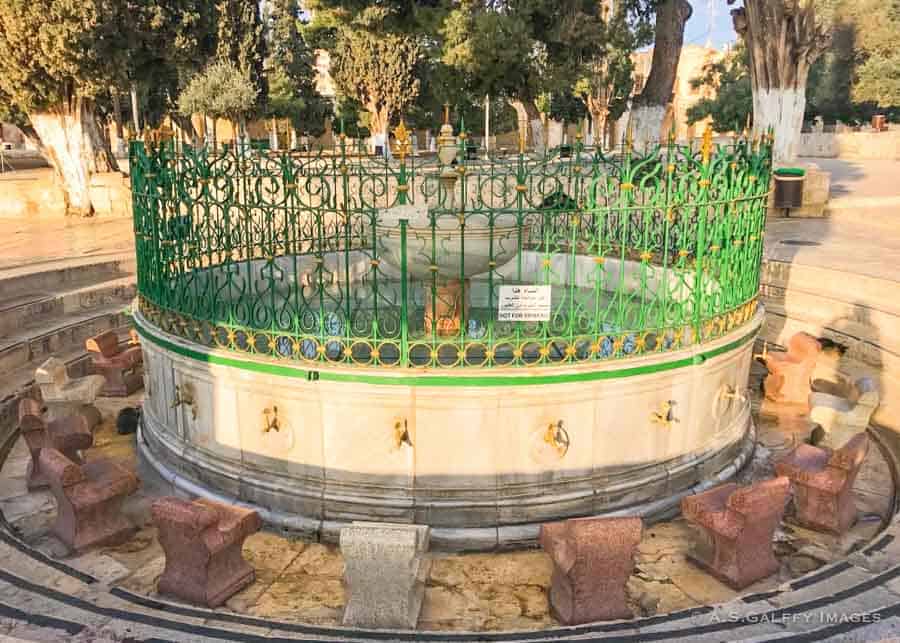
This is where Muslims wash their feet before entering the mosque. According to Islam, every Muslim must purify himself before he prays. You’ll find this kind of fountains in the vicinity of every mosque.
This beautiful domed fountain that sits on the western esplanade is very easy to miss. Compared to the Dome of the Rock, the fountain is really small but nonetheless one of the most beautiful structures on the Temple Mount.
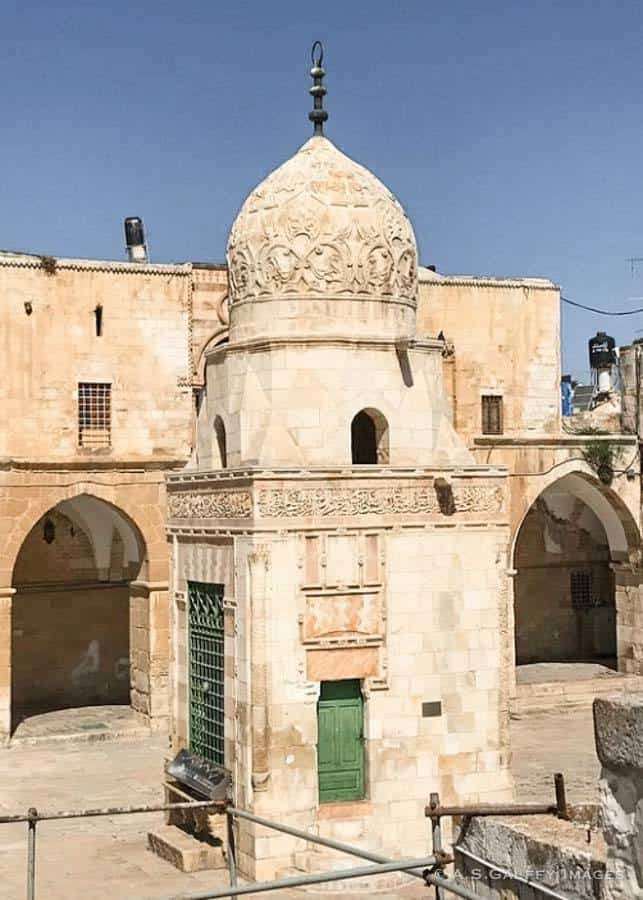
Also known as Sabil Qaitbay (in Arabic), the Fountain of Qayt Bay was built in the 15th century by the Mamluks of Egypt. Water used to pour from the shaft near the door of the fountain into ditchs below each window.
The Muslim authorities may have different requirements on different days. We friend visited Temple Mount wearing long pants and long sleeve shirts and had no problems.
Our friend visited the compound a few weeks later wearing pants and was told she needed to wear a long skirt. She had to rent a wrap from the entrance. If you know what to expect in Israel , things like these should not surprise you.
It’s better to come prepared, so bring a wrap just in case they ask you to cover your pants. Also, bring a scarf to cover your hair. They say you don’t have to do it, but you never know! I covered my hair anyway just to avoid being kicked out.
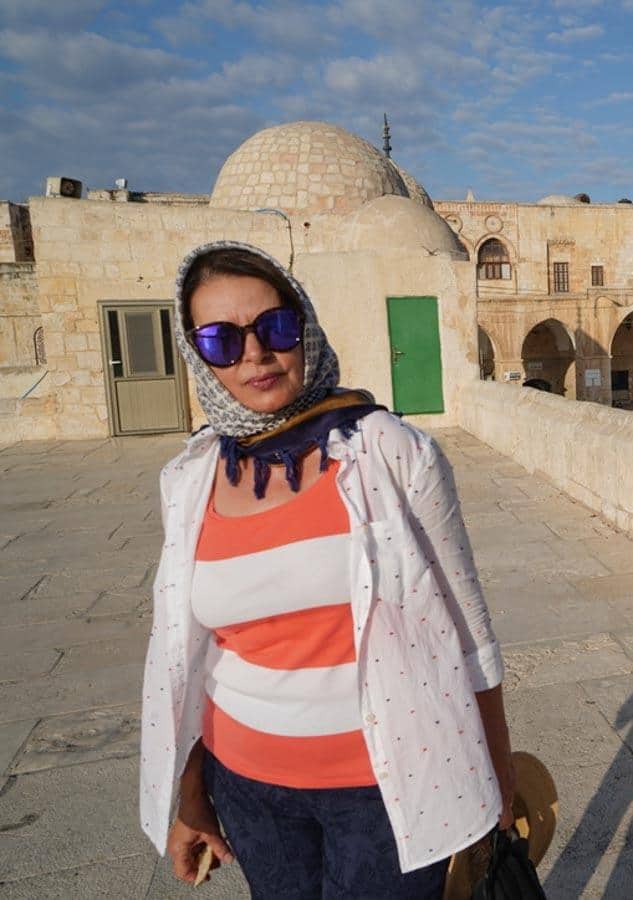
As a general rule, women should wear modest clothes that go down below the knees and cover their arms. No sleeveless shirts or shorts for men or women. Also, avoid physical contact with your partner. We have been scolded for trying to get closer together in order to take a selfie!
- Arrive early as the lines may be very long
- Bring water, sunscreen and a hat as there is very little shade around
- Dress modestly and wear clothing that covers your knees and arms
- Bring your passport for the security check point
- Don carry any Bible, prayer book, or religious artifacts with you
- Temple Mount is a holy site, so be respectful
If you enjoyed reading this post, please pin it for later:
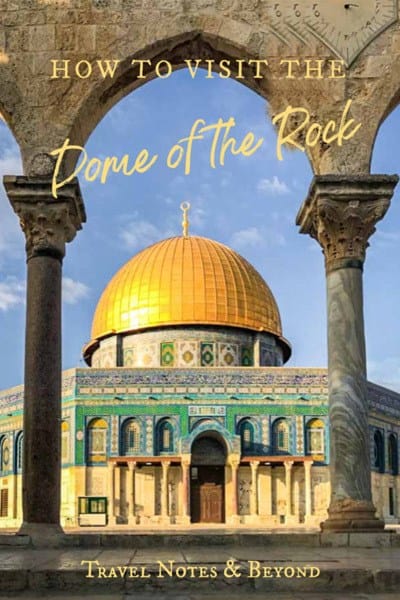
Anda is an award winning travel writer, avid globetrotter and passionate photographer. She is the voice behind "Travel Notes & Beyond," a collection of stories and travel impressions from her wanderings around the world. When she is not busy writing, traveling, or editing photographs, you can find her hiking in the foothills behind her house together with her husband and their dog.

Reader Interactions
Lilitz Palmer
October 23, 2021 at 6:41 pm
My friends are going to Israel in November and planning to go here. Where does the line start? Any info that you can provide is highly appreciated.
October 24, 2021 at 11:07 am
We visited the Temple Mount in late October and every time se passed by the entrance the line was all the way to the Dung Gate. In order to avoid the line we came to the entrance first thing in the morning, 10-15 minutes before they opened. The line was very short. The crossing process lasted only 10 minutes.
Rhonda Albom
January 27, 2020 at 1:24 pm
I am embarrassed to admit that I don’t know a lot about this area. Thanks for the great information and advice. I’m sure that one day I will visit Jerusalem. I am surprised that access to Temple Mount is controlled by Jordan.
Anda Galffy
January 27, 2020 at 1:27 pm
I was surprised about that too, Rhonda, but then when you get deeper into the conflict between Israel and its neighboring countries, you’ll understand why.
Debra Schroeder
January 23, 2020 at 8:03 am
Great photos, you were lucky to get ones without any people. I visited the Dome when I was in Israel in 2008. It’s one of those things that never change. Although, it looks like the checkpoint has.
January 22, 2020 at 2:28 am
Great post!! I couldn’t have found your post in a better moment as I have been planning my trip to Jerusalem and honestly after reading many reviews from people you have tried to visit the dome of the rock, I felt it is better to be left out but now I am somewhat optimistic about adding it to my list again.
January 21, 2020 at 7:51 am
I must admit this post comes at great timing when I start planning my travels to this astonishing country. Like you said no travel is complete without a visit to the Dome of the Rock and reading all about it does help understand its significance. The architecture is the main driver for me to visit it whilst the historic past and religious significance adds to it. It is always good to arrive early to these attractions as they can get very busy at peak periods when hundreds of visitors arrive. Thanks for a great post
Yukti Agrawal
January 20, 2020 at 7:41 pm
I always see Jerusalem on TV and is interested to visit this interesting place. The Dome of the Rock where there was Holy Jewish Temple previously looks stunning and good to know it was completed in 692 AD and one of the oldest Islamic structures in the world. I loved the pictures of the Dome which is really a monumental building with intricate patterns of mosaic, faience and marble works. Thanks for sharing all information about how to visit Dome of the rock.
Jennifer Prince
January 20, 2020 at 7:16 pm
I loved my time there when I went! It was long ago. It is totally understandable why Muslims are the only ones allowed in as it is a place of worship. It is totally beautiful, too!
Linda (LD Holland)
January 19, 2020 at 3:32 pm
When we visited Jerusalem, we only got to see the golden dome from afar. It was an amazing site to see glowing on the horizon. But I am now sorry we did not get a visit there on our day trip. But good to know that only Muslims can visit the Dome of the Rock. Not us for sure. The tile work on the outside looks stunning. Certainly not visible from afar. Thanks for taking me through this spot.
January 19, 2020 at 2:36 pm
I been to Jerusalem about ten years ago and to be honest, I wish I had this information back then so I could explore the dome of the rock. I have seen it from a distance but that is all. I found Jerusalem to be a confusing city to visit (and I don’t usually get confused on my travels) but I was only day for the day. i think I need a return visit.
Jeff Titelius
January 19, 2020 at 12:46 pm
WOW, what an encyclopedic overview Anda! While I knew some of the basics previously, I learned a great deal more about this sight’s religious significance and why it’s so revered by two religions, Judaism and Islam, both of which I am not at all familiar with. Thanks for encapsulating the details so brilliantly!
January 20, 2020 at 1:54 pm
Thank you for your comment, Jeff. Hope you’ll visit the Dome of the Rock sometime in the near future.
January 19, 2020 at 5:15 am
I visited Jordan a couple of years ago and was so disappointed that I didn’t get to visit Israel. Jerusalem is definitely a must visit and this post is really interesting. I didn’t know too much about The Dome of the Rock but I really want to visit it now!
January 19, 2020 at 11:06 am
Hope you’ll visit Israel soon, David.
Leave a Reply Cancel reply
Your email address will not be published. Required fields are marked *
Save my name, email, and website in this browser for the next time I comment.
COPYRIGHT NOTICE
All rights reserved © Travel Notes & Beyond. The material on this website is protected by copyright law. Republishing the content on this blog (including text, photography, etc.) is strictly prohibited.

AFFILIATE PROGRAM DISCLOSURE
Some of the pages and posts of this blog contain links to products and services that may be useful for my readers. When clicking on these links you will have the option to purchase or register for a service at no extra cost to you, but doing so can help me offset the costs associated with running this blog. Thank you for your support!
Temple Mount

Most Recent: Reviews ordered by most recent publish date in descending order.
Detailed Reviews: Reviews ordered by recency and descriptiveness of user-identified themes such as wait time, length of visit, general tips, and location information.

Also popular with travelers

Temple Mount, Jerusalem
- (0.12 mi) Chain Gate Hostel
- (0.20 mi) Ecce Homo Convent
- (0.27 mi) Austrian Hospice
- (0.44 mi) Christ Church Guest House
- (0.31 mi) Hashimi Hotel
- (0.23 mi) Bassem’s Gallery & Cafe
- (0.24 mi) Abu Shukri
- (0.27 mi) The Quarter Cafe
- (0.29 mi) Austrian Hospice
- (0.50 mi) Roots Restaurant

Jerusalem tours, hotels, attractions & more

The Temple Mount Tour
Allaboutjerusalem » Tour » The Temple Mount Tour
Entrance Fees
Difficulty level.
What happens when the site holiest to Jews is the third holiest site to Muslims and also important to Christians? You get a very volatile spot…
It is, however, also a very beautiful one. A tour of the open (and safe) areas of the Temple Mount allows one to be impressed by the history, culture and religion of Islam as well as the always spectacular Jerusalem view. The topic of our tour is the holiness of Jerusalem to Islam. There are no Jewish ruins on the face of the mountain and we will not be getting into the politics regarding the area.

We begin at the entrance to the Temple Mount at Mugrabi Gate, next to the Western Wall plaza, one of nine open gates of the Temple Mount The Temple Mount in its present form was built by Herod during the second temple period and its size today, as it was then is 144 dunams (35.5 acres). More than 100 Islamic buildings were originally built on the site by the Muslims, and building continued by the Crusaders in the seventh century.
It is important to understand the atmosphere in the seventh century in order to understand how Jerusalem became holy to Islam. Umayyad rulers based in Damascus had captured the city from the Christian Byzantines, but it was also a time of struggle between the Umayyad dynasty and their Abbas rivals, based in Mecca and Medina.

In order to use the city as leverage against Christianity and Judaism, and against the Abbas dynasty, the Umayyads set about islamicizing the city. Today, one can see the ruins of the Umayyad palace near the southern wall and adjacent to the Dung Gate (Western Wall excavations). Mohammad’s final prayer According to Islamic tradition, Mohammad arrived on the back of a winged horse named “el-Buraq” or “The Lightning.” After tying the horse to the Western Wall (still known in Arabic as “el-Buraq”), Mohammad prayed at al-Aqsa and then ascended to heaven.

The Mosque was initially built as a temporary wooden mosque by the Caliph Omar. In the year 705 it was rebuilt by the Caliph el-Walid of the Umayyad dynasty on Herodian ruins from the second temple period.
Earthquakes forced the rulers in Jerusalem to repair it more than once, and the mosque, one might say, has a lot of patches.
The mosque’s current facade is from the 13th century, from the time of the el-Ayyubid ruler el-Muathim. The facade features characteristic European crosses, due to the Salah al-Din, who conquered the city from the crusaders and was influenced by their building methods. Unfortunately, Jews cannot enter the mosque today. Every mosque in the world faces Mecca, which is located in Saudi Arabia, therefore this mosque face south. In the center of the prayer wall, known as a “qibla” is a prayer niche, known as a “mihrab.” One can see from the entire expanse of the mount and even adjacent to us, that the elevated “mihrab” are facing south.

In the past, next to the mihrab, a wooden prayer stand was placed that Salah al-Din brought by himself from Damascus. It stood for over 700 years until 1969 when a deranged Australian Christian name Rohan set it on fire.
And it was here that Jordan’s King Abdullah was murdered in 1951 was murdered. One of the bullets is still affixed to the marble pillars (The pillars, by the way, are Italian and were donated Benito Mussolini in 1938).
Adjacent to the mosque, to the east in the direction of the southern wall, are the arches that Herod built in order to support the southern area of the plaza which is actually suspended in midair.
This hall of arches was named Solomon’s Stables by the crusaders, because the Templar knights that inhabited the area in the 11th century used it as a stable (and the mosques as churches). Since 1996 there has been a mosque located in the stables called al-Marawani, in memory of the Caliph whose sons built the dome of the rock and whose grandson built the al-Aqsa mosque.

We turn to the north, in the direction of the Dome of the Rock and stop near the adjacent fountain used for drinking and purification before prayers. It was built in the Mamluke period in the 14th century.
We continue up the stairs to the upper section of the complex, through a set of arches called “ma’avzin,” or scales. According to Islamic tradition, people’s deeds will be weighed here when they die.
In the center of the arches is an impressive sundial, built at the beginning of the 20th century. The Muslims asked Rabbi Moshe Shapira, a Jewish clock builder, to build a clock for the arch, but as a religious Jew, Shapira would not go up to the Temple Mount (Jewish law precludes entry to the Temple Mount in a state of ritual impurity).
When the offers turned into threats, Shapira moved to Petah Tikva and never returned to Jerusalem. The clock was built by someone else.
We continue up the stairs to the Dome of the Rock, called Qubbat as-Sakhrahin in Arabic, in all its glory. To the east is a small domed building called the Dome of the Chain, Qubbat as-Salsalah in Arabic.
Others say this building was used to collect funds for the upkeep of the Temple Mount.

According to Islamic tradition, King David sat here, next to the Temple, to judge his nation with the help of a “miracle chain” that hung off the roof of the building. During crusader times, the building was used as a church in memory of Jacob, Jesus’ brother, who, according to the Armenians, is buried in the Armenian Quarter.
According to one Jewish tradition, this is the place both where Jacob had his famous dream about the ladder (Gen. 28:10) and where the tablets of the Ten Commandments are hidden.
The Dome of the Rock was built in the year 691 by the Caliph, Abdul al-Malik, who also built the first Arab city, Ramle, the capital city at the time. It is one of the oldest complete buildings in the Middle East.
True it is “only” 1300 years old, but eight supporting walls and its being built on the “noble rock”, have kept it in excellent condition.
Many books have mistakenly referred to the site as the Mosque of Omar. It just isn’t true. When the Caliph Omar conquered the city from the Christian Byzantines in the year 638, he asked the Patriarch Sophronius to take him to the holiest place in Jerusalem. Sophronius tried to trick him and take him to the Church of the Holy Sepulture, but not to be fooled, Omar explained that if he prayed there it would become a mosque and both religions would always fight over it.
The Caliph’s answer was simple: he left the church, laid a prayer mat on the floor and prayed, and today there is a mosque with a nice turret next to the church with “Omar’s Mosque” written on its gates. From there the Caliph continued to the Temple Mount and cleaned the holy rock inside the building with his cape. Thus, the Mosque of Omar mistake.
But the Dome of the Rock was actually built to protect from the rock, which Muslims believe is the foundation stone of the entire world and is also where the bible says Abraham nearly slaughtered his son, Isaac.
The ceramic blue pattern that adorns the outside walls dates to the 16th century, and the golden dome itself was redone in 1994, with 80 kilograms of gold, donated by Jordan and Saudi Arabia at a cost of USD 15 million. Special gold alloy was used to cover the dome so it wouldn’t be too shiny and cause temporary blindness. Inside the building, off limits to Jews, is the “noble rock.” The face of the mount has changed over the years, but there is little doubt that the Dome of the Rock stands on the site of the Temple.
In one of the upper corners of the rock, is a wood box in the shape of a tower, which holds, according to tradition, the footprint of Mohammad. According to Islamic tradition, King Solomon is buried next to this gate.
Below the noble rock, is a cave where Mohammed is said to have prayed. The ‘mihrab’ adjacent to the steps on the right (going down) was dedicated to King Solomon and believed to be one of the first prayer niches in the Muslim world. On the floor of the cave is a marble plaque and below it, according to the locals, is where many treasures from the temple are hidden.
The Temple Mount is open to visitors (without reservations and for free) on Sunday – Thursday between the hours of 7:30 and 10:00 a.m.
TODAY PHOTOS
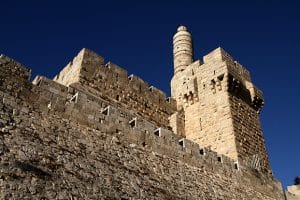
Jerusalem Videos
אתרים וסיורים קשורים , סרטוני וידאו קשורים, get free updates.

Copyright 2024 © All rights Reserved.
Book a group tour, fill the form on the right side and we'll get back to you..
- Daily Tours Jerusalem Day Tours Tel Aviv Tours Dead Sea Day Tours Galilee & Golan Day Tours Bethlehem & Jericho Christian Day Tours Tours from Tel Aviv Tours from Jerusalem
- Tour Packages Mini Packages, 2-3 Days Classical Tour Package Christian Tour Package Jewish Tour Package Galilee & Golan Package Israel and Jordan
- Private Tours Jerusalem Private Tours Dead Sea Private Tours Galilee Private Tours Israel Shore Excursions Airport Transfers
- Destination Jerusalem Tours Dead Sea Tours Masada Tours Nazareth Tours Galilee & Golan Tours Tel Aviv Tours Caesarea Tours Bethlehem Tours Jericho Tours Petra & Jordan Tours
- Petra Tours Petra from Jerusalem Petra from Tel Aviv Petra from Eilat Petra 1-Day Tours Petra 2-Day Tours Jordan Tours from Israel Israel and Jordan
- Shore Excursions Haifa Shore Excursions Ashdod Shore Excursions
- Blog Activities in Israel Israel Culture Practical Travel Info Jordan Travel Guide

- Bein Harim Israel Tours
- Jerusalem Tours
Mount of Olives, Temple Mount, Dome of the Rock Tour
- Language Schedule
- Tour on Map
- Tour number: 29

Tour Overview

The Mount of Olives, Temple Mount & Dome of the Rock Tour starts with a complimentary hotel pick-up then we proceed to the Mount of Olives for a breathtaking panoramic view across Jerusalem. Descending the Mount of Olives to Kidron Valley we see ancient monumental Jewish tombs and reach the Old City where we enter via the Dung Gate. We visit Temple Mount where Solomon’s Temple and the Second Temple once stood. Today Temple Mount is home to the Dome of the Rock and Al-Aqsa Mosque. If Temple Mount is closed to visitors, we will visit the Tower of David instead. We continue to the Davidson Center, an archaeological park flanking Temple Mount where we can see excavated architectural elements from the First and Second Temple periods as well as exhibits in the Davidson Center Museum. At the end of the tour, you are returned to your hotel.
Sites During the Tour
Highlights - mount of olives, temple mount & dome of the rock tour, availability, pickup places and prices, what to expect - mount of olives, temple mount & dome of the rock tour.
The Temple Mount tour starts at the Mount of Olives, where you can enjoy spectacular views of Jerusalem’s steeples, domes, and towers, as well as the Old City walls and Temple Mount. Pass by many beautiful churches on the Mount en route to Kidron Valley, located between the Mount of Olives and the Old City walls. In Kidron Valley, view the magnificent 1st-century tombs of Absalom, Benei Hezir, and Zechariah.
Continue to the 16th century Dung Gate where the tour enters the Old City and takes you to Temple Mount, a site held sacred by Christians, Muslims, and Jews. It was here that Solomon built the First Temple which was destroyed in 587BC. The Second Temple stood on Temple Mount from 516 BC to 70AD. The Temple held the Ark of the Covenant where the Ten Commandments were kept. Today the mount is home to the magnificent Dome of the Rock built in 687AD; the Al-Aqsa Mosque, the third holiest site in Islam and the Dome of Chains. You can see these impressive structures and learn about Temple Mount’s incredible history. On occasion, the Temple Mount is closed to visitors, if so the tour will visit the Tower of David instead of the Temple Mount.
Next, we visit the Davidson Center an archaeological site alongside Temple Mount. Here you can see excavated artifacts and architectural structures from various historical periods including the First and Second Temple Periods, Byzantine, Muslim, and Crusader eras. Among the archeological finds at the Davidson Center are walls from the First Temple Period; steps leading up to the Temple Mount; a Second Temple era street; ritual baths and more. The tour comes to an end when you are returned to your hotel.

Additional Information - Mount of Olives, Temple Mount & Dome of the Rock Tour
The tour includes:.
- Pick-up and drop-off service
- A fully qualified and licensed tour guide
- Transport by air-conditioned vehicle
The tour does not include:
- Food and drinks
- Entrance fees
- In the event that Temple Mount is closed to visitors, we will tour the Tower of David
- Temple Mount tours require Modest dress; covered knees and shoulders
- This tour operates with a minimum number of participants
- Entrance to Temple Mount is subject to strict security measures
- Security checks are conducted at the entrance to Temple Mount.
- Please note that no religious objects (including Bible) or weapons of any kind are permitted on Temple Mount
- The tour proceeds on foot through the Kidron Valley and Old City; a minimum level of physical fitness is required
- Entrance to Dome of the Rock is allowed for Muslims only
- Booking is subject to terms and conditions
Cancellation Policy
- 4% charge for notification up to 2 days or more before the start time of the tour.
- 25% charge for notification of a day before the start time of the tour.
- 100% charge for notification on the same day of the tour.
A day tour is a regular tour that we operate on specific weekdays. Tours depart from Tel Aviv, Jerusalem, Herzliya and Netanya. You have the option to upgrade your tour and ensure for yourself a place in a small group (up to 19 people). The tour duration from pickup time is approximately 10 hours. You will be picked up from your hotel, and after the tour, you will be returned to your hotel.
Almost all of our daily tours are operated primarily in English, in addition to a second language: Or Spanish, or Russian, or German and or French. You can choose the preferred language of the tour when booking. You can view the tour schedule, as well as the second language schedule in order to make your best suited choice.
When booking your tour, you will need to mark which language you’d like the tour to be in. Note that for certain tours in certain languages, the price may be higher.
A regular group travels in a coach that comfortably transports up to 45 people. A small group travels in a minivan that seats 22 people. Other than that, the tours are identical.
Our tours leave from Jerusalem, Tel Aviv, Netanya and Herzliya. We pick up our travelers from most of the hotels in these cities. If you are staying at a private residence address, please choose the closest pick up hotel to your apartment or contact our office to be advised where to wait.
Children under 12 and students (with a valid student card) receive a 10% discount.
You can bring your luggage with you and we’ll store it in the trunk of the vehicle during the tour. However, please be aware that we don’t take any responsibility for any damage or loss. Recommended to advise us that you are travelling with luggage.
Yes, but not too much. We definitely recommend bringing some local currency with you to pay for lunch and anything you may wish to; purchase along the way.
We, at Bein Harim Tourism, understand that plans can change, so you can change dates, cancel, or change your pickup point. Please note that cancellation fees will be charged subject to the cancellation policy as indicated on the tour page and confirmation email.
Since packages depend on hotel availability and updated rates, changes may imply an extra fee. For any changes or updates, you are welcome to contact our Operations team at:
Email : [email protected]
Whatsapp messages only : +972 526588837
Phone : +972 35422000
Make sure that you have received confirmation for your change or update request.
It is possible to have pick ups/ drop offs in different cities. However, we do not disperse to specific drop off locations. The expenses to get from the drop off location to your final destination won't be covered by Bein Harim.

Extra Savings!
- Promo code to use on you next booking
- Exclusive offers and latest travel deals
- Weekly recommendations

Congratulations!

Or just pick up the phone:

All the answers you're looking for in one place!
Tours You May Like
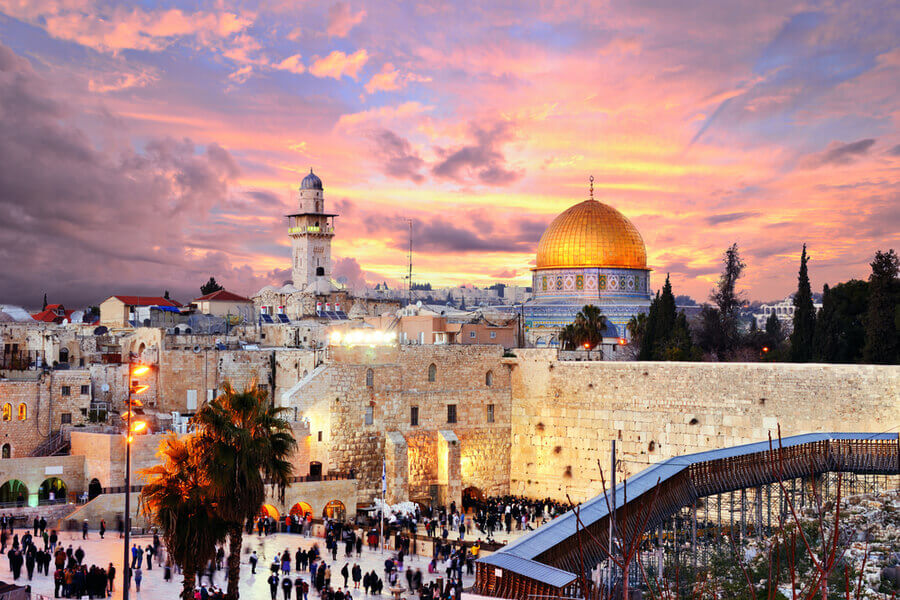
Jerusalem Old and New Day Tour
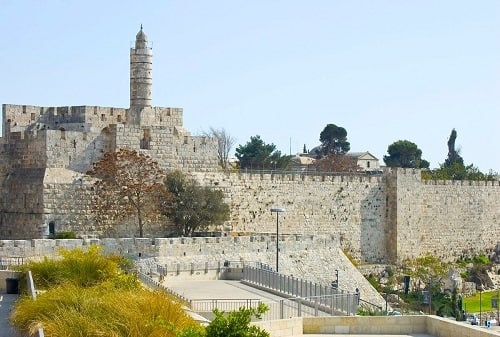
City of David Tour Jerusalem
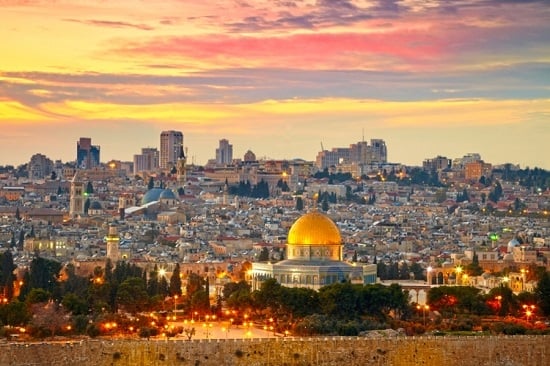
Jerusalem Classical Private Tour
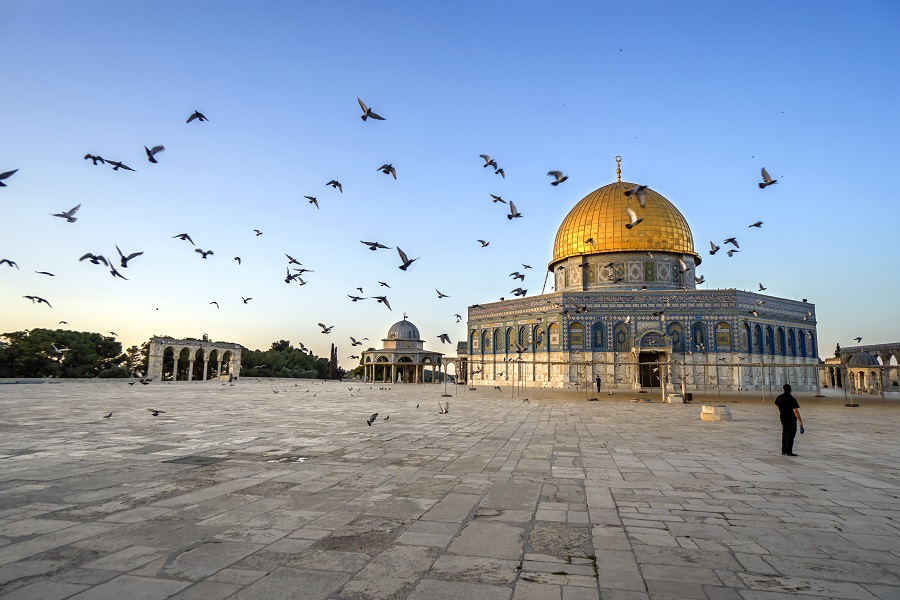
Thank you for subscribing
Keep in Touch

Customer Care
Get to Know Israel
Popular Destinations
Our Services

The Temple Mount
The temple mount.

The Temple Mount: Dimensions
At the beginning of the Second Temple period, the area of the Temple Mount was five hundred cubits square (approx. two hundred and fifty square meters). During the time of Herod, the area was greatly expanded and reached its present day dimensions, approximately 36 acres (150,000 square meters). The Holy Temple and its courtyards were situated on the Temple Mount.

The Temple Mount: 2nd Temple Era
The bottom left picture depicts the Temple Mount following Herod's expansion to current size, (approximately 36 acres). The top left picture highlights the Holy Temple and the area of the Temple Courtyards, surrounded by the low wall known as the Soreg , beyond which point Jews with tamei met (impurity due to contact with a dead body), and non-Jews, were forbidden to enter. The picture on the right shows Temple kohanim and Passover pilgrims with their lambs, passing through openings in the Soreg .

The Temple Mount Walls: The Eastern Wall
The wall surrounding the Temple Mount rose to a height of forty cubits. However on the eastern side the wall was lower, so that the kohen (priest) could see directly into the entrance to the Heichal (Sanctuary) of the Holy Temple, while standing on the Mount of Olives, (also called the Mount of Anointing), due east of the Holy Temple, where he slaughtered and prepared the ashes of the red heifer.

The Temple Mount: The Stoa & Watchtowers
The Levites kept watch in watchtowers which were situated in the four corners of the wall surrounding the Temple Mount plaza. The Stoa was a covered area that stood on pillars, (a portico, or colonnade) ran along the entire circumference of the Temple Mount plaza.

The Temple Mount: Sanctity
The Temple Mount was defined as the "Levite Camp." The source for the sanctity of the "Levite Camp" is the Camp of the Levites in the desert; its parallel in the Temple is the entire Temple Mount plaza (seen in the pictures on the right inside the red line), enclosed by the Stoa colonnade. Maimonides writes: “The Temple Mount is more sacred than the city itself, in that women who have just given birth [and others who are temporarily impure] may not enter it... [On the other hand,] a corpse may be brought there, and certainly one who is impure from having come in contact with death may enter” (Beit HaBechira 7:15).
Those forbidden to enter onto the Temple Mount Plaza (Levite Camp) were:
Men and women experiencing irregular emissions.
Menstruating women; Women who had recently given birth.
Lepers. (Lepers were also forbidden to enter the walled city of Jerusalem.)
The Soreg: Those who had been rendered impure through exposure to the dead were not allowed to proceed beyond the Soreg fence, which was a low built partition,(seen in the pictures on the left inside the red line). A number of openings in the Soreg allowed for pilgrims who were permitted, to pass through.
Gentiles were permitted to enter the Temple Mount up until the Soreg fence. Large signs made of stone were placed along the Soreg with warnings engraved on them, forbidding entry to gentiles and those who were impure. Some of these signs have been found in archaeological excavations. Written in Greek and Latin, the signs state: "The stranger may not pass the Soreg and the partition around the Temple. A stranger who enters, does so at his own risk.”

Temple Mount: Uses & Duties
The Temple Mount served as a gathering place for the pilgrims arriving on the three festivals.
The Stoa area also served as a storage place for various items such as the four species, which were placed there during the Sukkot festival, when it occurred on the Sabbath.
The picture on the right shows Sukkot pilgrims holding their four species ( arba minim ) which they have just taken from the Stoa where they had been temporarily stored.
On the left can be seen a cross section diagram of the Stoa portico which surrounded the Temple Mount. Behind it is a model of the Temple Mount. The pitched red covered the Stoa along the southern edge of the Temple Mount. Along the western, northern and eastern walls the Stoa has a flat white roof.

Temple Mount: The Outer Gates: The Chuldah Gates
The Chuldah Gates are the southern gates of the Temple Mount. These gates served as the main entrance to the Temple Mount, since the majority of the population lived in the City of David area, which was south of the Temple Mount. The Chuldah gates served as both entrance and exit and therefore were double. The double gates let into a tunnel that took the pilgrims up to the Temple Mount plaza.
Two reasons are suggested for the gate's name:
A. The prophetess Chuldah was in the practice of sitting there. (see 2 Kings 22:14–20 and 2 Chronicles 34:22–28)
B. The underground tunnels that led from the gates up to the Temple Mount complex resembled tunnels made by a mole in the ground. ( Chuldah is Hebrew for "mole.")

Temple Mount: The Chulda Gates: Sanctity
Through these gates one entered the area of the Temple Mount, whose sanctity paralleled that of the "Levites Camp." However, since the gates themselves were beneath the level of the Temple Mount, and there is a principle that the underground tunnels were not sanctified, those who were forbidden to enter the Temple Mount plaza were permitted to enter the gate compound.
Pictures on left show the location of the Chuldah Gates tunnels exits on the Southern portion of the Temple Mount, (designated by arrows), and the Gates themselves, (designated by circles).
The top right model of the 2nd Temple era Temple Mount shows the Chuldah Gates entrances at the base of the southern wall of the Temple Mount.
The bottom right picture depicts Passover pilgrims with their Passover lambs, outside the Chuldah Gates. The pilgrims are removing their leather sandals in preparation for entering the gates and ascending the Temple Mount. It is forbidden to wear leather shoes on the Temple Mount.

Temple Mount: The Kiponos Gate
The Kiponos Gate was located on the western side of the Temple Mount, just south of where the contemporary Western Wall Plaza is today. There are many opinions as to the origin of the name. For example, Kiponos is possibly the Greek name of the man that constructed the gate, or alternatively, the name of a rose garden that was adjacent to the gate. (Kiponos is Greek for "rose;" Source: Tractate Midot 1:3).
The pictures on the right depict Holy Temple pilgrims approaching the Kiponos Gate on Shavuot (top picture) and on Passover (bottom picture).
The Kiponos Gate was located north of today's Western Wall Plaza and is identified with today's Shalshelet (Chain) Gate, through which Jewish worshipers on the Temple Mount exit the Mount.
All the gates of the Holy Temple were twenty cubits high and ten cubits wide. The Kiponos Gate had a square lintel as did the other gates opening into the Holy Temple Plaza, (with the exception of the Tadi Gate), and its doors were overlaid in gold.

Temple Mount: The Kiponos Gate: Function:
The Kiponos Gate served as an entry and exit for the Temple Mount. All those entering would enter on the right side, walk around the Temple Mount and exit on the left side. The interior area of the gate had the level of sanctity as the Temple Mount.

Temple Mount: The Tadi Gate:
The Tadi Gate was the northern gate, one of the five gates of the Temple Mount. It was located next to the Antonia Fortress, built by Herod for protecting the Holy Temple. This gate did not serve as an entrance or exit for pilgrims, but was used exclusively by Temple kohanim who had become impure and therefore was situated in the north, closest to the Place of the Hearth and the Priests' Immersion Chamber. From there the kohanim would exit through a special tunnel directly to this gate. There are those who opine that the name was not Tadi but Tari, which indicates the gate's special lintel built from two stones, one leaning on the other, together forming a triangle - "tri" in Greek. (Source: Tractate Midot 2:3). Like all the gates of the Holy Temple, the Tadi Gate was twenty cubits high and ten cubits wide. The interior side of the gate had the same level of sanctity as the Temple Mount.

Temple Mount: The Shushan Gate
The Shushan Gate was the name of the eastern gate, one of the five gates of the Temple Mount. The source of the name Shushan: The Jews that returned from the Babylonian/Persian exile etched the image of the city of Shushan (the Persian capitol) on the gate - to signify their appreciation to the Persian kingdom that was instrumental in building the Second Temple. Like the other Temple Mount gates, the Shushan Gate was twenty cubits high and ten cubits wide, and its doors were overlaid in gold. The Shushan Gate's lintel was lower than the Temple Mount wall. This enabled the kohen who stood on the Mount of Olives and officiated in the burning of the red heifer to look above the gate, and gaze directly through the eastern gate of the Women's Courtyard. In this manner the kohen was able to see into the entrance of the Sanctuary, thus fulfilling the requirement that he must "face the Tabernacle" while preparing the red heifer. When a red heifer was slaughtered and prepared, the kohen and those that accompanied him led the red heifer out through this gate, and across a special bridge, to the Mount of Olives. On Yom Kippur an individual was appointed to exit through this gate with the scapegoat that was cast away in the wilderness as an atonement. The interior of the gate had the same level of sanctity as the Temple Mount.
Note: The Hebrew measurement, " amah ," translated as cubit, is the length of a fore-arm: 50 centimeters, (20 inches).
Top left picture: The Shushan Gate is designated by the red circle.
Bottom left picture shows the preparation for the burning of the red heifer, while the kohen (priest) faces the Temple Sanctuary.
Right picture shows the se'ir l'azazel (the scapegoat) being led out of the Temple via the Shushan Gate on Yom Kippur.

Temple Mount: The Temple Mount Plaza
The Temple Mount Plaza is located on Mount Moriah and is also called the "Outer Courtyard." The festival pilgrims would gather here before entering the Holy Temple. The Temple Mount featured five gates: the two Chuldah Gates in the south, the Kiponos Gate in the west, the Tadi Gate in the north and the Shushan Gate in the east. The people that entered the Temple Mount would initially walk to the right except for mourners. These would walk against the flow of the crowd - to the left. This was done to make their situation apparent to the public, thus enabling them to receive condolences.
Entrance to the Temple Mount is forbidden while carrying a walking stick (as a showy sign of status, not as an aid for walking, which is permitted), while carrying coins bundled in an obvious manner, while wearing leather shoes or while engaged in any other activity that would convey a lack of respect. Additionally, one was forbidden to use the Temple Mount as a short cut between two points. (Sources: Tractate Midot 2:2; Brachot 62).
In the two bird's-eye pictures the Outer Courtyard is highlighted. It extends from the perimeter of the Temple Mount Plaza up to the low Soreg Wall which begins the area of greater holiness where entry is restricted to Jews who were not impure through exposure to death.
The top left picture depicts Passover pilgrims streaming through the Outer Courtyard and entering into the Cheil - the area beyond the Soreg.
The bottom right picture depicts a kohen (Temple Priest) walking through the Outer Courtyard at dawn. He is receiving a signal from the kohen in the far tower that the sun has appeared in the eastern sky and it is time for the morning service to begin.

Temple Mount: The Cheil
The area between the Soreg and the wall of the Courtyard is called the Cheil . In the Cheil , there were 12 stairs leading to the courtyards of the Holy Temple. The width of the Cheil was ten cubits (approximately 50 centimeters, or 20 inches) around the entire Courtyard. According to Torah law, its holiness was only that of the "Levite Camp." However, as a safeguard, our sages enacted extra measures of stringency regarding entry past the Cheil . Only Jews who were pure (of the spiritual impurity contracted through contact with a corpse) were permitted entry. When the Eve of Passover occurred on Shabbat, several changes were made in the Passover offering procedure due to the Shabbat prohibition on carrying from one domain to another. Generally, after the offering was brought, the people would take home the permitted parts to roast and eat. On the Shabbat, however, this is not permitted, and so everyone would remain within the Temple area until the end of the Shabbat.
The two top pictures depicting bird's eye views of the Temple Mount shows the area of the Cheil in highlight. The bottom picture depicts a Temple scene on the Shabbat of Passover Eve (as described in Mishna Pesachim 5:10). The first group of those who came to bring their Paschal lamb has finished; they wait (at right) in the Temple Mount plaza for the end of Shabbat. Aside them can be seen one of their offerings, wrapped in the lamb’s skin, with the slaughtering knife leaning upon it. The second group waits in the Cheil (rampart), on the steps (at left) behind the Soreg (latticed gate) partition. The third group is seen still in the Azara (Inner Courtyard, far left), waiting there until darkness falls. When three stars are seen, and Shabbat is over, all depart to roast their Passover lambs in Passover ovens throughout Jerusalem.

Temple Mount: The Temple Mount Wall
The wall surrounded the Temple Mount on four sides. Its height was about forty cubits, except for the eastern wall, which was shorter. The wall delineated the area of the holy Temple Mount. The wall had five gates: the Kiponos Gate in the west, the Shushan Gate in the east, the Tadi Gate in the north and the two Chulda Gates in the south. At the corners of the walls were watchtowers in which the Levites kept watch. The eastern side of the wall was the oldest, dating from the time of Solomon's Temple. It is generally thought that the other walls were built by Herod.
The wall was built from giant stones, which were quarried from the mountains around the city of Jerusalem. Some of the stones that were found reached a length of 14 and a half meters! The wall rose to a height of about twenty meters. The wall had a gate on every side, and on the southern side there were two gates called the Chuldah Gates.
The Temple Mount Wall surrounds the "Levite Camp." Beyond the wall, men and women experiencing irregular emissions, menstruating women and women who had just given birth were forbidden entry.
The two bird's-eye view pictures show the Temple Mount support walls highlighted. The bottom picture depicts a group of pilgrims facing the Holy Temple from the Mount of Olives, east of the Temple Mount. They see, by the reflection of the rising sun in the Golden Lamp which was suspended above the entrance to the Temple Sanctuary, that it is time to recite the morning "Shema" prayer. The lamp was a gift from Queen Helena, a convert to Judaism.
"The Largest Stone, (see photo), also known as the 'Western Stone', is the biggest stone of the Western Wall in Jerusalem and can be found in the Kotel Tunnels. It is recorded as one of the heaviest objects ever lifted by humans without the assistance of any machinery. This stone is about 45 feet in length (13.6 meters), about 13 ft. wide (4 meters), and weight about 570 tons. The Largest Stone was revealed by during the Western Wall tunnel excavations. The open area of the Western wall is about 200 feet in length and most of it is buried under the ground. The tunnels serve as an avenue for additional access of the wall at about 1600 feet."
Subscribe to our weekly newsletter to receive the latest news and updates
No thanks, I’m not interested!
Subscribe Weekly Newsletter
- +91 8281 360 360
- [email protected]
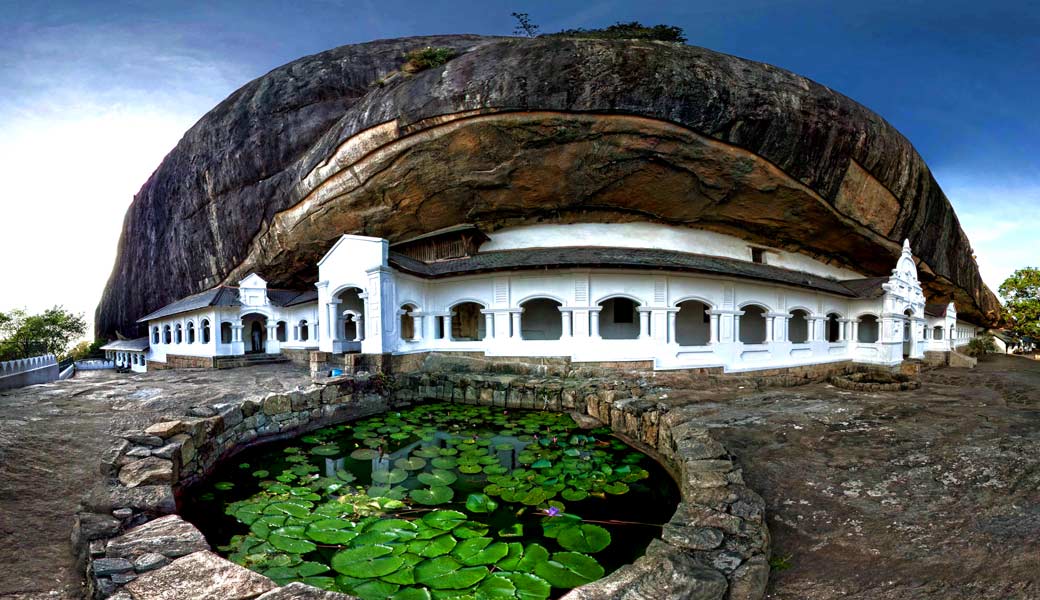
Dambulla Cave Temple, Sri Lanka
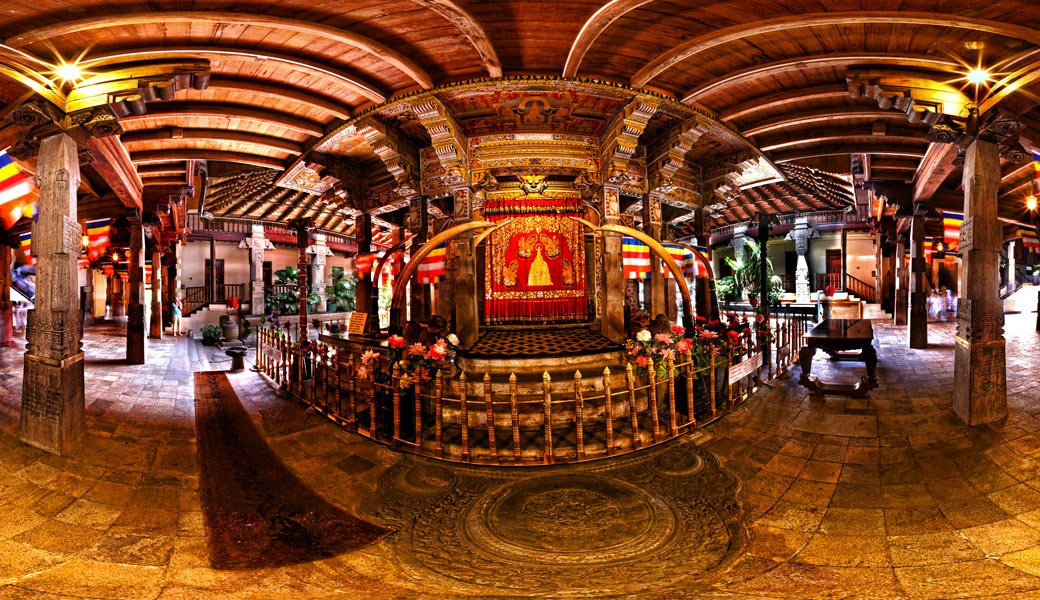
Tooth Relic Temple, Kandy, Sri Lanka
- Website View website
The Western Wall Tunnels 360 Virtual Tour
The 360-degree virtual tour of the western wall helps online visitors to explore this oldest jewish temple in jerusalem from anywhere in the world at their convenience..
The Western Wall (also known as the Wailing Wall, or the Kotel) is one of the last remaining walls of the ancient Jewish Temple in Jerusalem .
The Western Wall, or “Wailing Wall”, is the most religious site in the world for the Jewish people. Located in the Old City of Jerusalem, it is the western support wall of the Temple Mount. Thousands of people journey to the wall every year to visit and recite prayers. These prayers are spoken or written down and placed in the cracks of the wall. The wall is divided into two sections, one area for males and the other for females. It is one of the major highlights of any tour of the Old City.
The Temple was destroyed in 70 CE by the Romans, and much of what remains of the original structure is a small portion of an external supporting wall. Though it was not originally an important part of the Temple, this wall is considered an extremely holy place today. Located on the Temple Mount in Jerusalem‘s Old City, Jews and non-Jews from all over the world visit the Western Wall to pray and meditate. It is customary to write short prayers on pieces of paper and leave them in the crevices of the wall.
The Western Wall’s holiness in Judaism is a result of its proximity to the Temple Mount. Because of the Temple Mount entry restrictions, the Wall is the holiest place where Jews are permitted to pray, though the Foundation Stone, the most sacred site in the Jewish faith, lies behind it. The original, natural, and irregular-shaped Temple Mount was gradually extended to allow for an ever-larger Temple compound to be built at its top.
This process was finalized by Herod, who enclosed the Mount with an almost rectangular set of retaining walls, made to support the Temple platform and used extensive substructures and earth fills to give the natural hill a geometrically regular shape. On top of this box-like structure, Herod built a vast paved platform that surrounded the Temple. Of the four retaining walls, the western one is considered closest to the former Holy of Holies, which makes it the most sacred site recognized by Judaism outside the previous Temple Mount platform.
Click to watch the 360 virtual tours of Holyland
Created by Leen Thobias P4Panorama
Related posts
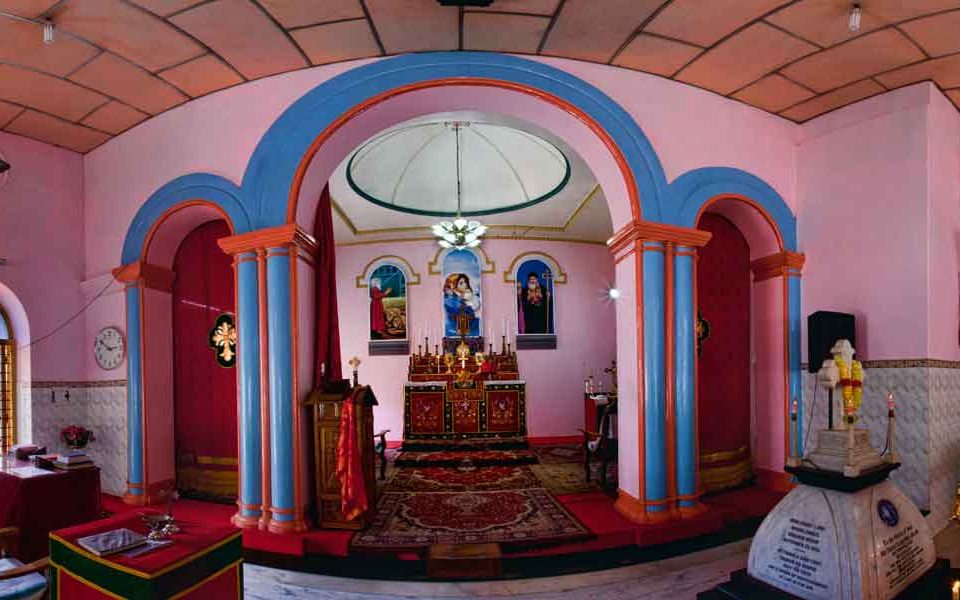
Take the 360 virtual tour of Manjinikkara Church, St. Stephens Jacobite Syrian Cathedral, Tomb of St. Patriarch Ignatius Elias III, Mor Ignatius Dayaro.
Manjanikkara Dayara Church
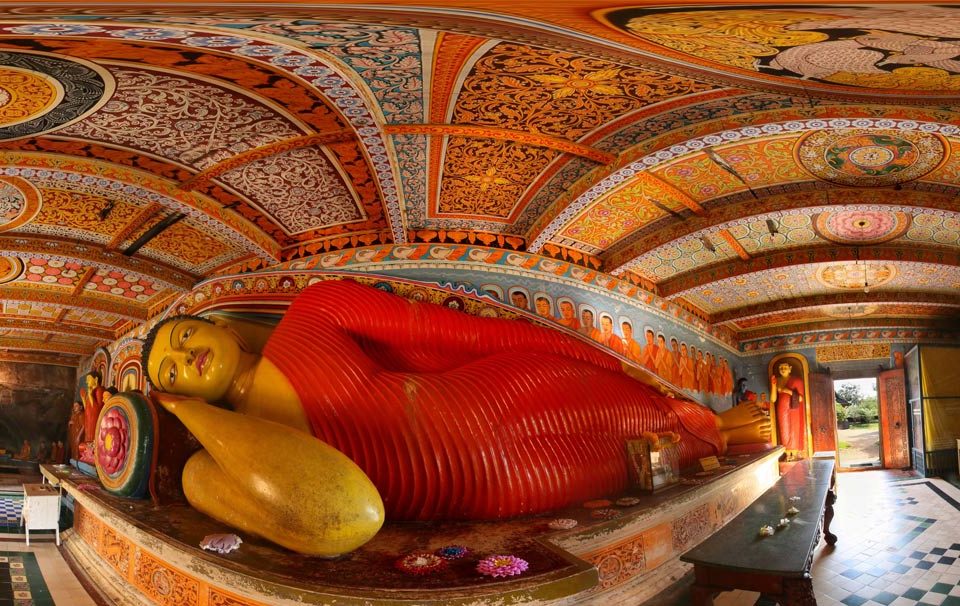
Take the 360 virtual tour of the Anuradhapura which helps the online visitors to experience this UNESCO site from anywhere and at any time. Just a click!
Sacred City of Anuradhapura, Sri Lanka
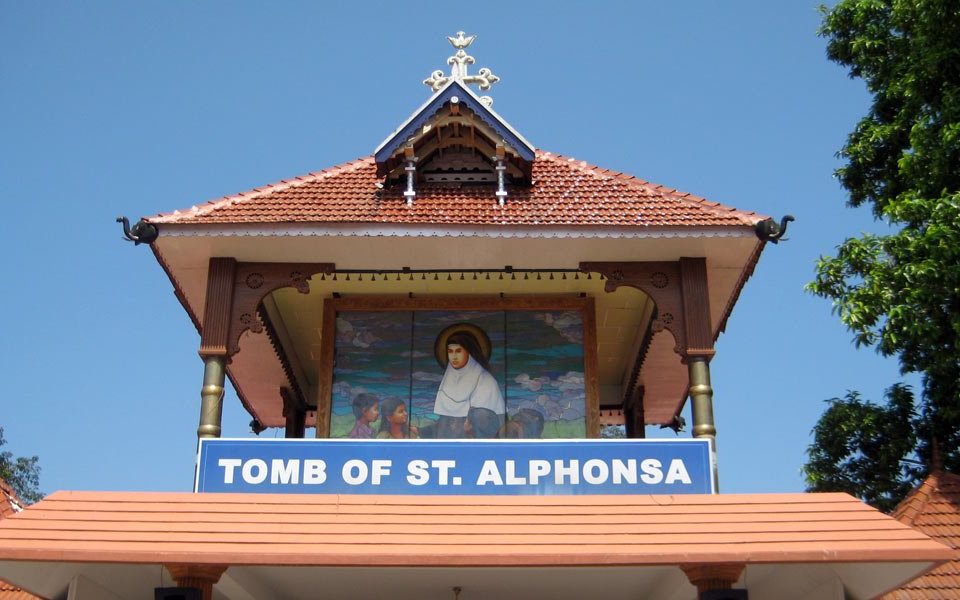
Take the 360 virtual reality tour of Franciscan Clarist Convent and St.Alphonsa Divine Home, Bharanganam, Kottayam, and watch the holy places online.
Saint Alphonsa Church, Bharananganam, Kottayam

The 360 virtual tour of Pattaya helps the online visitors to explore the place from anywhere and at any time. Just a click!
Pattaya Beach, Thailand

- Waterfront Enclave Water Land Road Kochi-682020 Kerala, India.
- Mob: +91 8281360360
- Tel: +91 484 4039385
- Level 14 Boulevard Plaza Tower 1 Downtown Dubai
© 2024 | p4panorma | Maintained By Vivek Sreekarthikeyam

COMMENTS
When visiting Jerusalem, many people want to see the Temple Mount and the Dome of the Rock. The Temple Mount is a holy site within the Old City of Jerusalem for Jewish, Christian, and Muslim people. All visitors are able to tour the compound and the Al-Aqsa Mosque, with the exception of the Dome of the Rock. The Temple Mount is one of the most ...
1,612 reviews. The Temple Mount in Jerusalem's Old City is a raised stone plateau that's home to some of the most significant religious structures in the world, including the Dome of the Rock, the Al Aqsa Mosque, and the Western Wall. The Temple Mount covers a 35-acre area known as al-Haram al-Sharif, and is considered to be a sacred place ...
To find it, look for an elevated wooden walkway by the Western Wall. Head up that and you'll eventually arrive at the security check for the entrance. 🌿 Travel Tip: The Dung Gate into the Old City of Jerusalem is the nearest gate to Temple Mount. You can also get there from the Lion's Gate or the Chain Gate.
On the tour we'll visit the beautiful golden Dome of the Rock, the Western Wall of the Temple Mount, incredible Roman and Crusader artifacts, enjoy fantastic views of the Mount of Olives, and much more! Jerusalem isn't just a treasure from the past; it's a living, functioning city today which adds another incredible twist to our tour.
Visiting hours for the Temple Mount are Monday through Thursday: Winter: 7:30 am - 10:30 am and 12:30pm - 1:30 pm. Summer: 8:30am - 11:30am and 1:30pm - 2:30pm. The Temple Mount is closed to visitors on Friday and Saturday. It may also be closed without notice for security reasons.
Temple Mount Private Guided Tour. 1. Historical Tours. from . $347.56. per group (up to 10) Jerusalem and Bethlehem, 2-Day Private Guided Tour from Amman. 7. Historical Tours. from . $629.99. ... Temple Mount is administered under the Waqf today. Non-Muslims are prohibited inside. Jews pray outside at the remnants of the Second Temple.
17 Temple Mount Guided tours. 18 Temple Mount Sightseeing. 19 Temple Mount Landmarks & monuments. 20 Temple Mount National parks. Cities in Israel. 1 Tel Aviv. 2 Jerusalem. 3 Eilat. 4 Ashdod. 5 Haifa. 6 Caesarea. 7 Nazareth. 8 Netanya. 9 Herzliya. 10 Akko. 11 Karmiel. 12 Capernaum. 13 Tiberias. 14 Aderet.
The Temple Mount in its present form was built by Herod during the second temple period and its size today, as it was then is 144 dunams (35.5 acres). More than 100 Islamic buildings were originally built on the site by the Muslims, and building continued by the Crusaders in the seventh century.
Temple Mount - One of the Old City of Jerusalem's most important religious destinations, the Mount played a crucial role in Judaism, Christianity, Islam & ancient Roman religion. Tour Details From 530 BCE to 70 CE, Jerusalem was heralded internationally for its grandeur & majesty.
Visit the historic Temple Mount without even leaving your home during this small-group virtual tour. Learn the significance of the millennia-old site to Jewish and Muslim faiths. See the ornate interiors of the Dome of the Rock and Al-Aqsa mosque, normally off-limits to non-Muslims. You'll also learn about the destruction of the First and Second Temples and the beginning of the Jewish diaspora.
The Temple Mount tour starts at the Mount of Olives, where you can enjoy spectacular views of Jerusalem's steeples, domes, and towers, as well as the Old City walls and Temple Mount. Pass by many beautiful churches on the Mount en route to Kidron Valley, located between the Mount of Olives and the Old City walls. ...
video tour with David Hyman , your Israeli professional tour guide. The golden Dome of the Rock on the Temple mount in Jeruslem, is the most iconic landmar...
Experience a detailed video tour showing everything there is to see on the Temple Mount. We'll explore Solomon & Herod's Temple Platform locations, the Anton...
A Journey Through Timeto The Depths of Jerusalem's History The Great Stone Route The Original Western Wall Tunnels Tour The Western Wall of the Temple Mount (also known as the Kotel) is one of the most magnificent and significant remnants in Jerusalem from the days of the Second Temple, destroyed approximately 2,000 years ago. The […]
The Temple Mount: Dimensions. At the beginning of the Second Temple period, the area of the Temple Mount was five hundred cubits square (approx. two hundred and fifty square meters). During the time of Herod, the area was greatly expanded and reached its present day dimensions, approximately 36 acres (150,000 square meters).
The amazing city of Jerusalem. A virtual tour of the Temple Mount. A holy site in Judaism, Christianity, and Islam for thousands of years.SummerInstagram:htt...
The 360-degree virtual tour of the Western Wall helps online visitors to explore this oldest Jewish Temple in Jerusalem from anywhere in the world at their convenience. The Western Wall (also known as the Wailing Wall, or the Kotel) is one of the last remaining walls of the ancient Jewish Temple in Jerusalem.. The Western Wall, or "Wailing Wall", is the most religious site in the world for ...
The tour does not include the fees for entering the sites; The tour would take place only if a minimum group of people booked it. Temple Mount is heavily secured site and requires to pass specific checks. No religious objects (Bible included) are allowed in the Temple Mount compound, as well as weapons of any kind.
Find and book city tours, helicopter tours, day trips, show tickets, sightseeing day tours, popular activities and things to do in hundreds of destinations worldwide, plus unbiased tour reviews and photos of tours and attractions from thousands of travelers. a Tripadvisor company. Top activities. Top categories. Walking Tours in Rome ...
4.2. The Museum of the Patriotic War of 1812 (350 rubles) Right next to this museum, but not in the Red Square but in Revolution Square, you can find the Museum of the Patriotic War of 1812 (the war against Napoleon), which is also managed by the State Museum of History. Hours: the same as the State Museum of History.
The Cathedral of Vasily the Blessed (Russian: Собо́р Васи́лия Блаже́нного, tr. Sobór Vasíliya Blazhénnogo), commonly known as Saint Basil's Cathedral, is an Orthodox church in Red Square of Moscow, and is one of the most popular cultural symbols of Russia.The building, now a museum, is officially known as the Cathedral of the Intercession of the Most Holy Theotokos ...